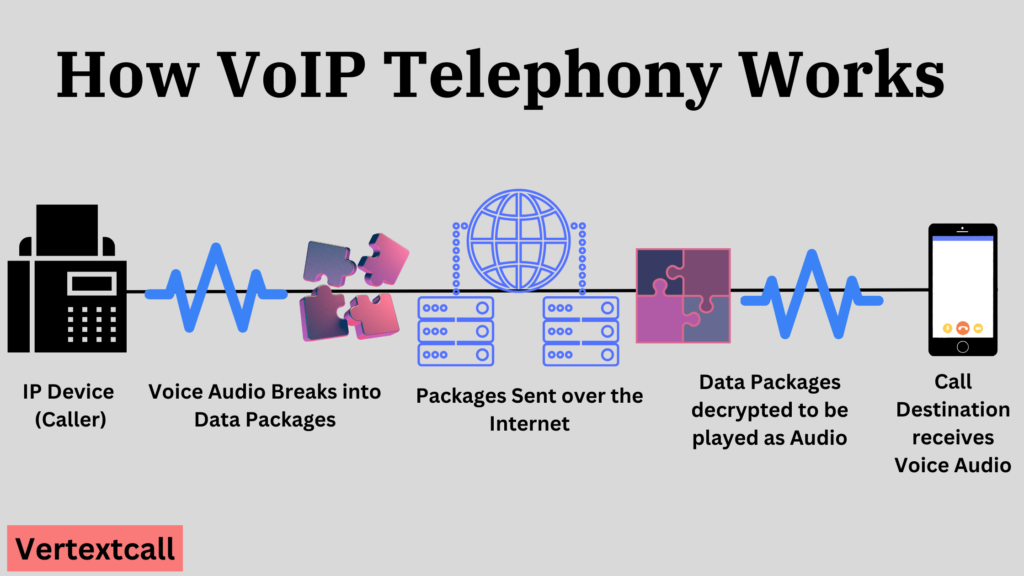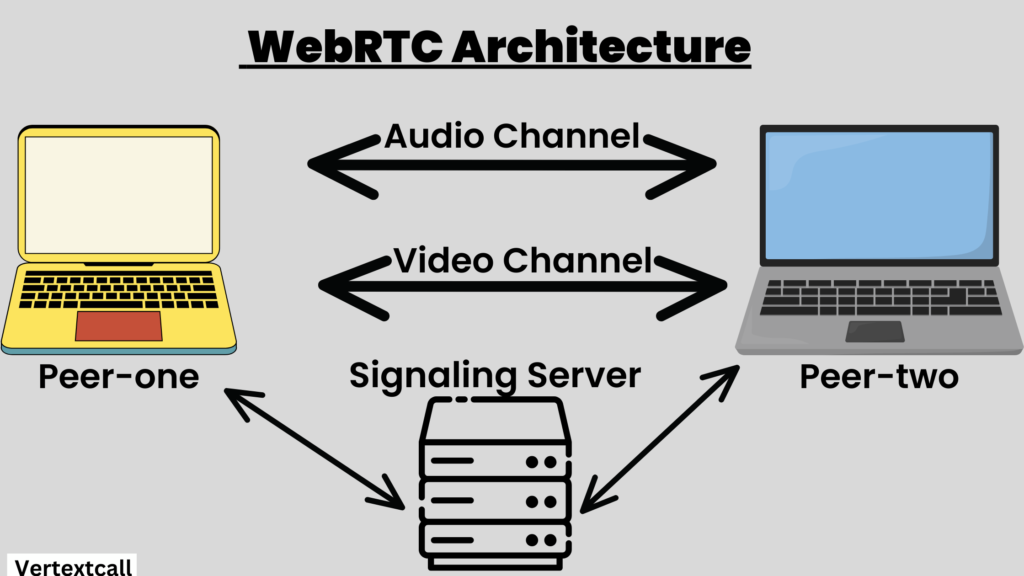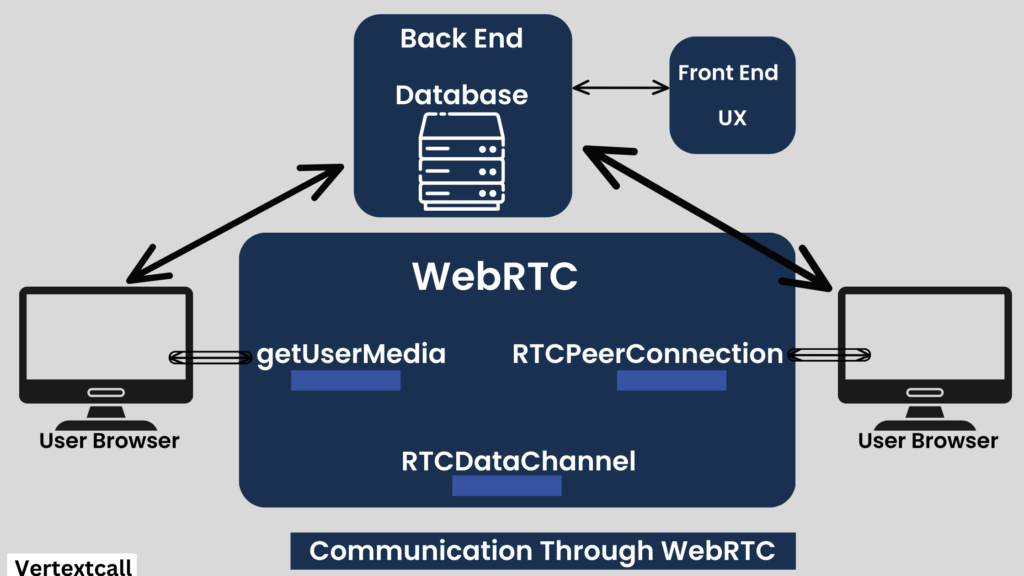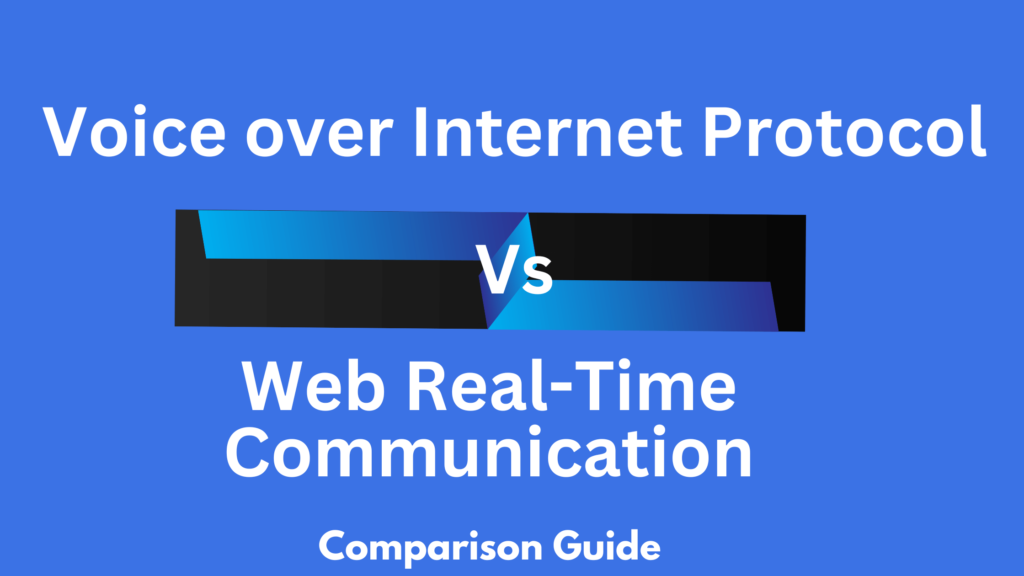As the digital environment advances, so do the communication tools that businesses depend on. VoIP (Voice over Internet Protocol) and WebRTC (Web Real-Time Communication) are key players in modern communication. But what sets them apart, and, more importantly, which is the best fit for your business?
This in-depth analysis explores the distinctions between VoIP and WebRTC, highlighting their technical differences, financial impacts, and security considerations.
Table of differences between VoIP and WebRTC
The following table provides a comparative overview of the key aspects of VoIP and WebRTC technologies.
Aspect | VoIP | WebRTC |
Definition | Technology for delivering voice communications over the internet. | Open-source tech for real-time communication on the web and mobile. |
Protocol | Utilizes various protocols such as SIP (Session Initiation Protocol), H.323, or proprietary protocols. | Uses standardized protocols including SRTP (Secure Real-Time Transport Protocol), STUN (Session Traversal Utilities for NAT), and ICE (Interactive Connectivity Establishment). |
Browser Compatibility | Typically requires a separate client software or app to make calls. | Built directly into web browsers, eliminating the need for additional software or plugins. |
Development | Often requires expertise in network setup, configuration, and management. | Easier to integrate into web applications with JavaScript APIs, reducing development complexity. |
Peer-to-Peer | Can support peer-to-peer communication but typically relies on central servers for call setup. | Supports direct peer-to-peer communication without the need for central servers once the initial connection is established. |
Mobility | Mobile applications are common but may require specific client software. | Supports mobile devices directly through web browsers, enabling seamless communication without additional apps. |
Security | Encryption and authentication are available but may require additional configuration. | Built-in security features like encrypted media streams and secure data channels ensure end-to-end security. |
Use Cases | Widely used in business environments, call centers, and residential applications. | Suitable for real-time communication in web-based applications including video conferencing, online gaming, and customer support. |
What is VoIP?
Voice over Internet Protocol (VoIP), a widely recognized technology, plays a crucial role in enabling voice communication over the Internet. The VoIP system works by converting our analog voice signals into digital packets, which are then transmitted across internet networks.

Protocols like Session Initiation Protocol (SIP) oversee call initiation, termination, and maintenance over IP networks. As a result, you can make phone calls using a variety of devices, such as smartphones, computers, or even traditional telephones with the appropriate adapters.
VoIP not only provides scalability and cost efficiency but also a range of advanced features. These features go beyond basic voice calls to include video calls, texting capabilities, and voicemail services, making VoIP a comprehensive solution for modern communication needs.
Related Reading: What is the difference between SIP and VoIP
What is WebRTC?
WebRTC (Web Real-Time Communication) is an open-source initiative, that allows web browsers to engage in direct peer-to-peer communication. This technology allows uninterrupted transmission of audio, video, and data without requiring additional software installations or plugins. Utilizing HTML5 and supported by major browsers, WebRTC provides smooth communication experiences with APIs that prioritize compatibility.
Unlike Voice over Internet Protocol, WebRTC is built for web browsers, using JavaScript APIs to establish secure, direct connections between your devices. By bypassing the need for traditional communication software, it streamlines the integration of multimedia communication into web services.
For businesses looking to incorporate instant, high-quality communication into their web applications, WebRTC presents a reliable and forward-looking solution.
What is WebRTC calling?
WebRTC calling enables voice and video calls directly from your web browsers, eliminating the requirement for external software or plugins.

This functionality utilizes the WebRTC API, which supports real-time communication by enabling the direct exchange of media and data between you and your recipient devices.
Key components such as getUserMedia, RTCPeerConnection, and RTCDataChannel work together in the browser to establish connections securely.
To know more about WebRTC components check out this Web.dev Guide
The main difference between VoIP and WebRTC
1/ Infrastructure and Implementation:
At the infrastructure level, VoIP and WebRTC take different approaches. VoIP relies on specific hardware and software, typically managed by a VoIP service provider or through the establishment of a private branch exchange (PBX) system.
On the other hand, WebRTC, known for its browser-based functionality, operates across various IP networks without requiring additional client software. This distinction highlights the flexibility and accessibility that WebRTC offers for real-time communication applications, making it a versatile choice for modern communication needs.
2/ Security Considerations:
When it comes to security protocols, VoIP commonly uses Secure Real-time Transport Protocol (SRTP) and Transport Layer Security (TLS) to secure voice calls and signaling. These methods aim to prevent eavesdropping and signal manipulation.
On the other hand, WebRTC incorporates security features directly into its framework. As a browser-based technology, WebRTC enforces end-to-end encryption for all communications, guaranteeing the confidentiality and integrity of data streams as a default measure. This strong focus on security in WebRTC protocols often establishes it as the more secure choice for real-time Internet communication right from the start.
3/ Cost Considerations:
VoIP, despite using an internet connection for communication, can involve costs for setting up hardware and software, along with maintaining and updating infrastructure. These expenses can be substantial for large-scale operations. While calls between VoIP users within the same network are usually free, charges may apply for calls to traditional phone networks.
On the other hand, WebRTC offers a cost-efficient solution by eliminating the need for specialized equipment or servers, reducing initial capital expenses. Its integration into web browsers utilizes existing internet infrastructure, lowering maintenance costs. As a browser-based technology supporting direct peer-to-peer communication, WebRTC can deliver significant cost efficiencies, especially if you run small to medium-sized enterprises or focus on online and app-based communication.
4/ Device and Browser Compatibility:
VoIP is known for its flexibility in supporting various devices, from traditional desktop handsets to modern smartphones. However, it often requires specific software installations or hardware adaptations, which might prevent new user adoption or slow down deployment on different platforms.
On the other hand, WebRTC is designed for cross-platform compatibility, eliminating the need for extra downloads or applications. This built-in compatibility significantly improves accessibility, enabling integrated communication across devices and browsers with minimal obstacles.
5/ Quality of Communication:
In terms of communication quality, both VoIP and WebRTC aim to provide clear audio. However, their methods and implementation differ. VoIP has advanced with high-definition (HD) voice technology, enhancing sound quality beyond traditional telephony standards. HD Voice utilizes wideband audio technology to expand the frequency range of audio signals, resulting in more natural and clear speech.
On the other hand, WebRTC is developed to adapt to diverse network conditions to ensure consistent communication quality. By utilizing advanced algorithms for echo cancellation, noise suppression, and automatic gain control, WebRTC maintains high-quality audio and video, even in challenging bandwidth situations.
6/ Assessing Scalability:
VoIP systems present a strong scalability framework due to their operation on established server-based networks, allowing efficient expansion to accommodate increasing user numbers. VoIP signaling protocols and infrastructure are carefully formulated to handle large volumes of simultaneous calls and sessions across extensive networks.
In contrast, WebRTC is designed to support high-quality direct communication sessions without intermediaries. This peer-to-peer method enables fast and effective user connections but can pose challenges when expanding to a larger audience. While WebRTC is excellent for one-on-one connections, scaling up requires well-thought-out solutions that include integrating additional components like signaling servers and TURN servers to navigate firewalls.
Related Reading: What is a VoIP Server?
What is WebRTC in VoIP
While VoIP and WebRTC operate differently in terms of infrastructure, the capabilities of WebRTC are being increasingly incorporated into VoIP systems functionality. This integration enables VoIP services to provide browser-based, real-time communication advantages of WebRTC, enhancing the user experience.
By integrating WebRTC features into the VoIP setup, you can easily initiate voice and video calls directly from web interfaces, eliminating the need for dedicated VoIP software or hardware. This incorporation delivers a unified communications experience, aligning with modern business needs for flexibility and compatibility.
How does WebRTC work

WebRTC function involves establishing direct peer connections through a series of JavaScript APIs. When starting a session, WebRTC utilizes Interactive Connectivity Establishment (ICE) protocols to determine the most efficient connection path between peers.
Moreover, the Session Traversal Utilities for NAT (STUN) server identifies users’ public IP addresses, while the Traversal Using Relays around NAT (TURN) server acts as a relay when direct peer connection is not feasible.
Once the connection path is established, WebRTC employs the Secure Real-time Transport Protocol (SRTP) to securely transmit audio and video data between browsers. This ensures data encryption and authentication, establishing a secure channel for private communications.
By using these technologies, WebRTC enables dependable, and secure exchanges directly in your web browser without requiring third-party plugins or software. This capability supports various real-time communication applications, including video conferencing and live streaming, offering reliability to address current business requirements.
Why is WebRTC better?
WebRTC offers several advantages, making it a popular choice for real-time communication applications. Here are some of the key advantages:
- Encrypted Communications: WebRTC, known for its reliable end-to-end encryption, plays a crucial role in securing all data shared between peers during online communications. This encryption not only protects privacy but also enhances security measures, ensuring a safe and confidential exchange of information.
- Cost-Effectiveness: With no need for specialized infrastructure and reduced reliance on third-party plugins or services, WebRTC stands out as a cost-effective solution for real-time communication. Its ability to establish direct peer-to-peer connections through browsers without the need for additional software installations makes it a user-friendly choice for various communication needs.
- Low Latency: WebRTC is designed for low-latency communication, with protocols and algorithms optimized to minimize delays in data transmission. This low latency is crucial for real-time applications where instant feedback is required, such as voice and video calls and live streaming.
- Platform and Device Independent: WebRTC is designed to work on any operating system and device that supports modern web browsers, facilitating cross-platform compatibility.
- Adaptive to Network Conditions: WebRTC utilizes dynamic quality adjustments based on network conditions. This adaptive approach helps ensure stable connections by optimizing communication quality in response to varying network performance levels.
What are the limitations of WebRTC?
- Variable Performance Across Devices: The performance of WebRTC may differ due to varying processing power and hardware capabilities of devices, sometimes affecting the quality of communication.
- Dependency on Internet Connectivity: Since WebRTC relies on Internet connections, any instability or loss of connectivity can disrupt communications, leading to dropped calls or frozen video feeds.
- Complexity in Scaling: While peer-to-peer connections are beneficial for small-scale use, large-scale implementations require additional infrastructure for signaling and managing connections effectively, complicating scalability efforts.
- Browser Compatibility: Despite wide adoption, variations in how different browsers implement WebRTC can lead to compatibility issues, potentially limiting cross-browser communication.
- Privacy and Security Concerns: Although WebRTC offers secure encryption, the exposure of IP addresses through ICE may raise privacy concerns. Also, your business must implement its signaling and STUN/TURN servers to conform to specific security requirements.
- Resource Intensiveness: Processing audio and video in real-time can deplete resources, particularly on mobile devices, resulting in battery drain and the risk of overheating.
Why is VoIP better?
While WebRTC offers set advantages, VoIP technology still holds several advantages over WebRTC in certain contexts. Here are some reasons why VoIP might be considered better than WebRTC in certain situations:
- Unified Communications: VoIP solutions often provide a more comprehensive suite of communications services beyond just real-time web communication, integrating with other tools like email, fax, and messaging under one platform.
Related Reading: Unified communications vs VoIP
- Quality of Service (QoS) Management: VoIP systems can offer QoS features that prioritize voice traffic over the network, ensuring higher quality audio calls even under bandwidth constraints, which is not inherently controlled within WebRTC implementations.
- Better Control Over Security: Although WebRTC offers end-to-end encryption, VoIP systems can be more closely managed for security, with the ability to integrate with enterprise-grade security solutions.
- Consistent User Experience: VoIP technology enables a more consistent performance and user experience by reducing reliance on browser implementations and the variability in web technologies.
- Dedicated Bandwidth: VoIP systems can be configured with dedicated bandwidth allocation, which helps in maintaining call quality and reducing latency, as opposed to WebRTC, which competes with other types of data on a shared connection.
- Customer Support: VoIP providers offer customer support and service level agreements (SLAs) to ensure that your businesses receive timely assistance and guaranteed uptimes, benefits that may not always be provided by WebRTC solutions.
- Economies of Scale: For larger organizations, VoIP systems provide better economies of scale, reducing the cost per user as the system grows, which can be more challenging with a peer-to-peer-based system like WebRTC for large user bases.
What is the differnce betweeen WebRTC, VoIP and Web Sockets?
The following table provides a concise overview of the differences between WebRTC, VoIP, and Web Sockets across various features and functionalities.
Feature | WebRTC | VoIP (Voice over Internet Protocol) | Web Sockets |
Definition | Real-time communication technology | Technology for transmitting voice and multimedia over the Internet | Communication protocol that enables bidirectional communication between web clients and servers |
Protocol | Uses various protocols including RTP, SRTP, ICE, STUN, and TURN | Primarily uses SIP (Session Initiation Protocol) for signaling and RTP (Real-time Transport Protocol) for media transmission | Uses TCP or WebSocket protocol |
Browser Support | Supported by major web browsers (Chrome, Firefox, Safari, Edge) | Requires VoIP client software or web-based applications with VoIP capabilities | Supported by most modern web browsers |
Use Cases | Video conferencing, live streaming, peer-to-peer file sharing, IoT communication | Business communication systems, call centers, consumer applications (e.g., Skype, WhatsApp) | Real-time chat applications, live updates, collaborative editing |
Security | End-to-end encryption for all communication channels, ensuring data privacy and security | Supports encryption and authentication mechanisms for securing communication channels | Supports encryption and authentication mechanisms, but additional security measures may be needed |
Bandwidth Usage | Optimized for efficient use of network bandwidth, minimizing data overhead and reducing latency | Efficient use of network bandwidth, but may require more bandwidth compared to WebRTC for similar functionalities | Efficient for low-latency communication but may require more bandwidth compared to WebRTC for similar functionalities |
Use Cases: When to Choose VoIP or WebRTC
Understanding the use cases of each technology is key to selecting the right one for your business needs.
When VoIP Performs Well:
VoIP excels in scenarios where a reliable and advanced communication system is needed, offering a range of business-centric features. Industries such as call centers, sales operations, and corporate telephony benefit greatly from VoIP due to its advanced call management capabilities. It provides a wide range of features, including call recording for quality assurance and detailed analytics for performance evaluation, making it a powerful solution for modern communication needs.
When WebRTC is Preferred:
WebRTC excels in several key scenarios. For businesses with a strong web presence like e-commerce sites or those that rely on continuous customer interaction online, WebRTC’s cohesive integration on web platforms offers a critical advantage. Additionally, it is the preferred solution for companies prioritizing remote work, enabling immediate communication effortlessly without the necessity of specialized hardware or complex setups. The flexibility and user-friendly nature of WebRTC make it a multipurpose tool for enhancing online communication strategies and promoting smooth collaborations in various business environments.
Frequently Asked Question
Q1) What is the difference between WebRTC and SIP?
Ans: The difference between WebRTC and SIP is that SIP primarily serves as a signaling protocol for initiating, maintaining, and terminating real-time sessions involving voice, video, and messaging applications. On the other hand, WebRTC represents a technological advancement aimed at enabling instant, browser-based communication without the need for additional plugins or third-party software.
Q2) What is the difference between WebRTC and Softphone?
Ans: The difference between WebRTC and Softphone is that while both are used to facilitate voice and video communication over the Internet, they differ significantly in their implementation and usage. A Softphone is an application, typically software-based, that functions as a virtual phone, replicating the features of a traditional telephone on a digital platform using VoIP technology.
In contrast, WebRTC is a browser-based technology that enables real-time communication (RTC) directly from web browsers without requiring external applications or plugins.
Q3) What is the difference between VoIP and HTTP?
Ans: The difference between VoIP and HTTP (Hypertext Transfer Protocol) is that VoIP is a broad technology category that includes any voice communications over the Internet. It facilitates the transfer of audio signals, such as phone calls, over the internet by packaging audio into data packets. Conversely, HTTP serves as a vital protocol for the World Wide Web. It plays a significant role in facilitating the transfer of hypertext documents, like web pages, from web servers to client browsers.
Q4) Is WebRTC only for Video?
Ans: WebRTC is not restricted to video communications. It supports a range of Immediate communication types, including audio, video, and data sharing. WebRTC enables web browsers to conduct voice calls, video chats, and peer-to-peer data transfers without the need for external plugins or applications, utilizing its flexible API set for various interactive capabilities.
Q5) Is WebRTC only for Browsers?
Ans: WebRTC is not restricted to just browsers; it can also be integrated into mobile applications, Internet of Things (IoT) devices, and various services or platforms requiring real-time communication capabilities.
Q6) Does WebRTC use VoIP?
Ans: Yes, WebRTC uses VoIP technology as part of its framework. While VoIP refers broadly to the transmission of voice and multimedia content over IP networks, WebRTC specifically enables VoIP communication to be directly embedded within web pages or applications without the need for external plugins or standalone VoIP clients. It is built with standard web technologies and supports real-time video, audio, and data communication.

